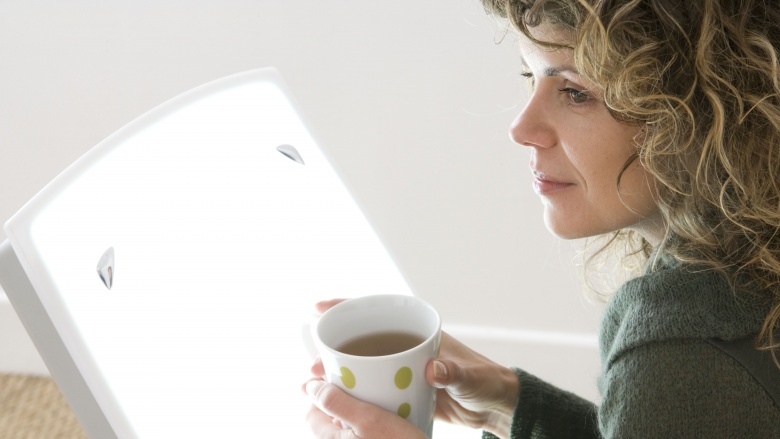4 Ways To Know If You Have Seasonal Affective Disorder
Winter can be a tricky time of year for almost everyone. First there's the issue of navigating the holidays, which can run the gamut from being joyous to stressful to downright miserable. And then, of course, there's the fact that the holidays are followed by the many dark, cold months of winter.
For me, thanks to glittering holiday lights (they're so pretty!), pre-holiday festivities (yay!), and, let's be real here, eggnog (get in my belly!), I get through December without any problems — but once January hits, I reliably get incredibly bummed out. It's as if a switch flips and, as soon as December's festivities are over, it goes from being the most wonderful time of the year to the most wretched.
By that point, I'm tired of the cold and snow (just as we're entering the true depths of winter, so the timing there is fabulous), and the lack of pretty holiday lights makes everything look so blah (why must we take them down just when winter starts getting really awful?). Plus, I feel all gross and bloated from too many cookies (we don't talk about that), I almost never see the sun, and the predominant colors outside are gray, brown, and black. Those factors combine forces to make everything seem just. So. Miserable.
It took me until after college to realize that, while I definitely have a longstanding predisposition to depression, it gets noticeably worse in the winter. This seasonal pattern of depression is called seasonal affective disorder (it's more commonly known by its super-appropriate acronym, SAD), and it turns out I'm not alone. Approximately 10 to 20 percent of the population experiences mild winter SAD, and nearly 5 percent suffer from a more severe form.
What is SAD, and who typically gets it?
SAD is a mood disorder, characterized by depression related to a certain season of the year — especially winter. It's important to note, though, that the 'blah' feeling goes beyond the winter blues, feeling tired, or just disliking winter. Instead, it's a type of clinical depression that starts around the fall or winter, and typically remits in the spring or summer.
While SAD can happen to anyone, certain people are more susceptible than others. It happens more frequently to people who live far from the equator (those long hours of darkness are to blame), people between the ages of 15 and 55 (the risk of getting SAD for the first time goes down as you age), and women. It also runs in families, so you're more likely to develop SAD if you have a close relative with it. Additionally, onset usually occurs during adulthood, and the average age of onset is approximately 23.
SAD can show up in many different ways, and while the symptoms listed here are the most common ones, each person may experience symptoms differently. No matter what exact symptoms they have, though, they're usually a collection of physical, emotional and cognitive symptoms, and they usually make life a lot more difficult.
Fatigue and leaden limbs
If you find that you go into full-on hibernation mode during the winter, it could be a sign of SAD. Sleeping more and still feeling tired can be a sign to watch for. Additionally, persistent tiredness, low energy, and oversleeping can be red flags. "While a person with winter doldrums may have difficulty waking up or getting out of bed at times, someone with seasonal affective disorder can't get to work on time," says Michael Terman, PhD, director of the Winter Depression Program at New York Psychiatric Institute and Columbia University Medical Center.
As if being extra tired isn't enough, it can get worse. Though it's not a classic way of being fatigued, a heavy, "leaden" feeling in your limbs can also be a sign of SAD.
Feeling irritable, moody, anxious or easily overwhelmed
If you don't feel like yourself during the winter — if you worry, brood, are more sensitive to rejection, or get angry more easily than during other times of the year — those mood changes can signal that SAD is afoot. Other issues, such as interpersonal problems like getting into more arguments or having difficulty interacting with others because you feel irritable and extra-cranky, can also be a sign of SAD.
Feeling overwhelmed is another emotion to watch out for, since tasks that normally seem simple or mildly irritating but manageable — like household chores, commuting, going to meetings, or paying the bills — suddenly become totally overwhelming when a person is dealing with SAD. For me, this is one of my most pronounced symptoms. When SAD strikes, things like doing the dishes seem insurmountably hard (I mean, I hate doing the dishes under normal circumstances, but when I don't have my SAD under control, having to unload the dishwasher and deal with a sink full of dirty dishes basically feels like the apocalypse. Full disclosure: that scenario has made me ugly-cry on more than one occasion).
Trouble concentrating
A person's ability to think clearly also becomes impaired when they're dealing with SAD, and this can be a tricky one. It's hard to notice you're not thinking clearly when your brain isn't firing on all cylinders (Another symptom I can speak to from personal experience! What a holiday miracle).
So, how can you keep an eye out for it? According to SAD expert Dr. John Docherty, this struggle to think clearly can cause many problems for people at work, including "decreased concentration, productivity, interest, and creativity; inability to complete tasks; increased interpersonal difficulties in the workplace; increased absences from work; and simply stopping work."
So, if you feel like your brain is inexplicably fuzzy, you're suddenly having trouble focusing, completing tasks feels like climbing Mt. Everest, or you now have the productivity of an average sloth, take stock of your other symptoms and consider whether SAD could be the at root of the issue.
Increased appetite and weight gain
As if SAD wasn't already a bummer, this is the icing on the cake. Many people eat more and specifically crave carbohydrates, such as bread and pasta. This, in turn, leads to weight gain — and not an insignificant amount, either.
"With the [winter] doldrums, it's in the norm to gain up to 5 or 6 pounds over the winter, but with full-blown SAD, weight gain can be far more than that," says Dr. Docherty.
Treating SAD
Ok, so that's the bad news. The good news, though, is that SAD is entirely treatable. (Hooray!) The most common forms of treatment involve light therapy, as well as lifestyle changes such as sticking to a routine, meditating, taking vitamin D supplements, getting consistent exercise, and even taking a vacation.
Light therapy
Because SAD is believed to be caused by a lack of exposure to sunlight, one of the easiest ways to cope is to — you guessed it — increase your exposure to sunlight, either through going outdoors to catch some rays or by sitting in front of an artificial sunbox.
If the weather is too cold or your schedule doesn't allow you to go outside during the day, a sunbox has special fluorescent tubes that mimic sunlight and is considered an acceptable treatment for people with any level of winter depression. Michael Craig Miller, M.D., of Harvard Health Publications, says the bright lights stimulate cells in the retina that connect to the hypothalamus, helping to bring your circadian rhythms back in check.
Stick to a schedule
Since trouble sleeping is a key symptom of SAD, it stands to reason that those suffering also have trouble waking up at the same time each day. However, creating and sticking to a schedule might be more to your benefit than you think. Experts at the University of Southern California's Keck School of Medicine recommend you "outline a schedule that enables you to wake up daily at the same time....[and] be consistent in your exposure to daylight and the times that you eat to help improve your mental outlook.".
Vitamin D and exercise
Getting more vitamin D is a simple change that can make a big difference. Known as the "sunshine vitamin," vitamin D levels plummet during the winter — and those low levels are linked to SAD. You can increase your intake of vitamin D by eating fatty fish, mushrooms, eggs, and vitamin D-fortified foods.
As for exercise, outdoor exercise is the most helpful. But if you can't exercise outside because the weather isn't cooperating, don't go trying to run up snowy hills when it's freezing outside, y'all — hit the gym and find a machine close to a window. An added bonus is that exercise can help mitigate some of the dreaded SAD-related weight gain, so it's a win on multiple fronts. Exercise will also help you feel more energized and productive, and, in the immortal words of Elle Woods from Legally Blonde, "Exercise gives you endorphins. Endorphins make you happy. Happy people just don't kill their husbands. They just don't."
Take a vacation
This is, by far, my absolute favorite recommendation. Seriously, a medically-mandated vacation to a warm, happy place? Sign me up. According to Charles Raison, MD, of Emory University's Mind-Body Program and an assistant professor of psychiatry and behavioral sciences at Emory's medical school, "There is some evidence that people with a higher tolerance to cold tend to be less depressed than those who are more susceptible to cold...Sometimes, something as simple as taking a week or two vacation to Florida or somewhere sunny during January or February can make a really big difference."
Say no more, good sir. I don't know about the rest of you guys, but I'm sold (BRB, checking the price of flights to the Caribbean).
Working with your doctor
Everything we've discussed so far has been part of a largely DIY approach to treating SAD, but if you feel like it's not helping as much as you'd like, don't hesitate to speak with your doctor. There's no shame in this (real talk: until I started being really proactive about managing my own raging case of SAD, winter would usually leave me weeping in fetal position under my desk), and your doctor can help you come up with a good game plan.
That game plan can involve cognitive behavioral therapy (CBT), which is a goal-oriented psychotherapy treatment that works to change thinking patterns and behaviors — and in the end, change the way people feel. When CBT was applied to SAD in one study, it was found to improve the symptoms and reduce chances of recurrence.
In addition to CBT, if need be, your doctor can also prescribe antidepressants to help you get through the winter. Antidepressants can greatly benefit some people with SAD, especially if symptoms are severe. If you wind up going this route, your doctor might recommend taking a seasonal course of antidepressants: starting treatment before your symptoms typically begin each year, and then weaning you off the meds once the season of your discontent is over. He or she may also recommend you continue to take the antidepressant beyond the time your symptoms normally go away, but that's for you and your doctor to discuss.
Kicking SAD to the curb
In my own experience dealing with SAD, it took a few years for me to realize that my irritability, hair-trigger tendency to get overwhelmed, desire to hibernate, and inability to concentrate weren't just due to fatigue and generic winter blues, which was my original self-diagnosis. It was only after I'd spent a few winters getting more sleep and consuming so much coffee I thought my heart would explode (I'd walk into a room, limbs twitching from all the caffeine, and basically be like "Hey guys! Who has two thumbs and just downed a quad venti latte? This gal!), that I realized fatigue and the usual winter doldrums weren't the culprit.
For me, the keys to managing SAD have been vitamin D and exercise (in addition to the treatment regimen for my existing depression), but the fact remains that different things work for different people. Although SAD is a tricky adversary — it can sneak up on you, and sometimes it can be hard to figure out what's going on — it's absolutely a foe that can be vanquished.












